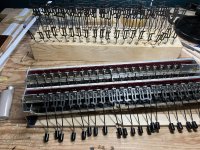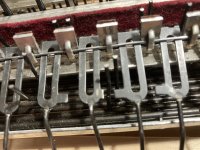Mr Mark
Squeezebaggeroni...
Ever worked on one of these? Every where I turn this old accordion is exhibiting some rather poor design elements…from the nut and bolt assembly with no access to the nut for holding down reed blocks to the downright nightmare of a bass mechanism - I will probably never touch one of these again  .
.
This came to me with fallen in bass buttons. Unbeknownst to me somebody somewhere along the way has already taken this apart and mixed up and bent a lot of the rods. This also required removal of the faceplate to get the mechanism out - there was no way those rods were going back in the holes elsehow.
So once you get it all apart you start to realize the problem - due to the way the rods flop loosely without support you literally have to take everything apart just to get the pistons back in the holes - they literally flop every which way. Now, the other end of the piston has the funky flat O shapes with tangs for the catorcetti…so, if you get one of these wrong you have to take the whole thing apart again…so….
Bass reeds have been taped off as this is now a treble instrument only. .
.
Just curious if anyone has a better (and obvious) way to get the pistons back in the faceplate holes without taken it all apart…not that I would mess with one of these again, but would like to know
This came to me with fallen in bass buttons. Unbeknownst to me somebody somewhere along the way has already taken this apart and mixed up and bent a lot of the rods. This also required removal of the faceplate to get the mechanism out - there was no way those rods were going back in the holes elsehow.
So once you get it all apart you start to realize the problem - due to the way the rods flop loosely without support you literally have to take everything apart just to get the pistons back in the holes - they literally flop every which way. Now, the other end of the piston has the funky flat O shapes with tangs for the catorcetti…so, if you get one of these wrong you have to take the whole thing apart again…so….
Bass reeds have been taped off as this is now a treble instrument only.
Just curious if anyone has a better (and obvious) way to get the pistons back in the faceplate holes without taken it all apart…not that I would mess with one of these again, but would like to know








